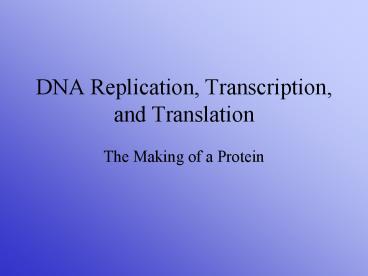DNA Replication, Transcription, and Translation PowerPoint PPT Presentation
1 / 27
Title: DNA Replication, Transcription, and Translation
1
DNA Replication, Transcription, and Translation
- The Making of a Protein
2
DNA Replication
- Process by which DNA copies itself
- Happens when chromosomes copy themselves before
mitosis and meiosis
3
Steps of DNA Replication
- 1. DNA untwists
- 2. DNA unzips (separates)
- 3. Corresponding free-
- floating nucleotides
- attach to original sides
- to form new base pairs
- 4. DNA reforms
- 5. 2 strands twist into helix
- animation
Identical Strand
4
- Complementary base pairing allows each strand
of DNA to serve as a template for DNA replication
5
SEMI-CONSERVATIVE REPLICATION
DNA Replication Something old and something new
in the daughter molecules, known as
semi-conservative replication (part of the
original DNA is conserved)
6
RNA - Ribonucleic AcidDNA Messenger Taxi
- RNA Structure Function
From DNA to Protein
7
What is RNA?
- Organic Molecule
- Nucleic Acid
- Three types
- mRNA messenger
- tRNA transfer
- rRNA ribosomal (combines with proteins to form
ribosomes)
Ribonucleic Acid
8
Where is RNA located?
- mRNA -in nucleus cytoplasm
- tRNA - only in cytoplasm
- rRNA found in ribosomes (cytoplasm)
rRNA
mRNA
mRNA
tRNA
9
What is RNAs structure?
- 1. Nucleotides
- a. Phosphoric Acid
- b. Ribose sugar
- c. Nitrogenous Bases
- Adenine-Uracil
- Guanine-Cytocine
- 2. Single Strand
- 3. No Twisted helix
- Phosphate (Acid)
- Sugar-Base
- Phosphate (Acid)
- Sugar-Base
- Phosphate (Acid)
- Sugar-Base
- Phosphate (Acid)
- Sugar-Base
10
Comparison of RNA DNA
- Acid
- Sugar-Base
- Acid
- Sugar-Base
- Acid
- Sugar-Base
- Acid
- Sugar-Base
- Acid Acid
- Sugar- -- -Sugar
- Acid Acid
- Sugar- Base -Sugar
- Acid Acid
- Sugar- Base- Sugar
- Acid Acid
Uracil
Thymine
Deoxy-ribose
Ribose
RNA
DNA Ladder
11
What are mRNAs functions?
- mRNA
- Copies the DNA code
- Goes out into the cytoplasm to tell the cell what
to do in order to stay alive - Delivers message to ribosomes (protein factories)
12
Why not send the original DNA code out?
- DNA is the master copy must be protected
- DNA might be damaged!
- DNA cant fit through nuclear pores
- mRNA components are reused
- To copy more messages
Original DNA
DNA in the nucleus is safe
mRNA -copy
13
Transcription
- 1. mRNA is copied from DNA
- 2. Occurs in the nucleus
- 3. Steps
- DNA untwists
- Unzip one gene in DNA
- RNA codons line up to corresponding bases on one
side of DNA - mRNA detaches from the DNA
- mRNA moves out of the nucleus and into the
cytoplasm
DNA GAG AAC TAG TAC RNA CUC UUG AUC AUG
14
RNA Review
- mRNA has
- Single strand
- Ribose sugar
- Uracil instead of thymine bases
- Nuclear membrane allows it to leave!
mRNA
A T C G
U A G C
I
I
I
DNA Code
15
Transcription
16
How does mRNA tell the cell what to do?
- mRNA is a message that codes for a protein
- Proteins are made in the cytoplasm and work to
keep the cell alive - Translation (protein synthesis) Process of
making a protein - Proteins are made up of amino acids (small
building blocks)
17
Transcription Review
18
There are 20 different types of amino acids
Protein
Amino Acids
19
Protein Synthesis
- Assembling Proteins from the DNA Instructions
20
- tRNA
- in cytoplasm
- Picks up an amino acid
- Taxis the amino acid to the ribosome protein
factories
Amino acid
tRNA
21
Translation
- Conversion of the message (mRNA code)
- into a protein by the ribosome factories
22
Translation
Nucleus
Cytoplasm
- 1. mRNA moves out of nucleus and into cytoplasm
- 2. mRNA attaches to a ribosome
- 3. Transfer RNA (tRNA) decodes the mRNA and
brings amino acids to build up the protein - 4. Protein (chain of amino acids) detaches from
ribosome and goes off to work in the cell
Ribosome
tRNA
Amino acid
Anticodon (3 bases on tRNA) Matches up to codons
on mRNA
23
4. Polypeptide Chain of amino acids grows
2. Peptide bond forms 3. tRNA leaves ribosome
- 1. tRNA delivers
- amino acid
24
Putting It All Together
Protein Synthesis
25
Genetic Code Code that matches codons in mRNA to
amino acids on tRNAs
mRNA codons (3 bases) Amino acids
Stop codon codes for the end of the mRNA (no
amino acid added)
Different codons code for different amino
acids!!!
26
Summary
- DNA Replication
- Make duplicate DNA
- In nucleus
- Copy the chromosomes
- Occurs before mitosis and meiosis
- Protein Synthesis
- Transcription
- - make mRNA from DNA (in nucleus, moves out into
cytoplasm) - Translation
- - make protein from mRNA code using amino acids
(on ribosome in cytoplasm)
27
Translation Review

